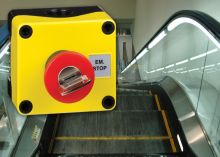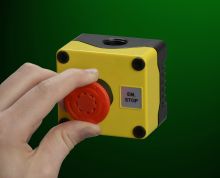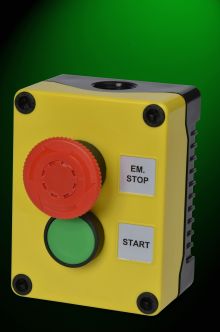
E-Stops & BS EN ISO 13850:2008 (formerly EN418) : The risks of installer liability.
Emergency Stop devices are an essential safety requirement for almost any electrical application which is operated in the public, industrial or commercial domain, such as escalators, large machinery and commercial plant vehicles. Such a safety critical device understandably is governed by legislation to make sure that it is suitable for the job in hand. So what are the risks of failing to install suitable Emergency Stop functions, and who could be found liable in the event of injury caused by component failure?
Alex D'Arcy, Sales Director for Hylec-APL, offers an insight into the current legislation and explains how installers who fail to specify suitable components could be at risk.
Emergency Stop devices can be found in any industry - industrial, commercial or retail. They are not only important to the safety of the machinery and people in an industrial environment, but they are also often required to be present on production lines, usually within the line of sight of workers. Furthermore, several E-stops may be required on a single machine, as they are commonly required to be mounted as frequently as every 2 metres along the production line.
Health and safety in the workplace is at the forefront of developments to modern machinery and there is a raft of regulations and directives from a number of sources that must be implemented by machinery manufacturers as well as those using the equipment. Amongst all the ‘red tape’ lies the EU Machinery Directive, 2006/42/EC and the European Standard for the Safety of Machinery Emergency Stop equipment, BS EN ISO 13850:2008, which replaced EN418, all of which define the specific requirements for emergency stop devices and actuators.
Equipment destined for use within the European Union must meet the requirements of the European Machinery Directive, which includes BS 13850 (EN418) .Initially, Annex I of the Directive states “Machinery must be fitted with one or more emergency stop devices to enable actual or impending danger to be averted.” This is accepted as meaning that all machines require an emergency stop unless there are exceptional extenuating circumstances where the risks cannot be controlled effectively with an emergency stop or if the risk would be increased or new risks would be introduced by the action of an e-stop system.
For the majority of cases which will require an e-stop, BS13850 (EN418) defines the specific requirements for emergency stop devices and actuators, which are summarized as follows:
* All Emergency OFF devices must be "self-latching" (maintained) devices. With regard to an E-Stop, this means it must be either a twist-to-release, pull-to-release or key-to-release device.
* The latching mechanism must be engaged prior to the electrical contact change-of-state to avoid a momentary OFF signal.
* All devices must have a "mushroom" head that is red in colour.
* The background immediately surrounding the Emergency OFF device must be yellow in colour.
* All Emergency OFF devices must have positive opening operation. This means there must be a direct mechanical link between the operation of the mushroom head and the contacts to drive the electrical contacts open. This protects against a potentially unsafe condition should the contacts weld. A spring action contact does not comply with this requirement.
* The devices must not be reset automatically; manual reset is a requirement.
The main concept of the standard is that emergency stop switches must have a "fool-proof" capability. Such an emergency stop device incorporates a latching mechanism which is activated when the actuator of the device is operated to a certain point. This latching mechanism prevents the actuator from being pulled back out again; it also ensures that the contacts will not be opened prematurely. The method by which the actuator is reset must be clearly indicated by arrows which are marked on the actuator or associated legend plate.
Resetting the electrical system can only be done by first releasing the E-Stop that was originally activated. If E-Stops were activated at multiple locations, all of them must be released before the machinery can be restarted. It should be noted that resetting E-Stops does not in itself restart the machinery; it only permits restarting through normal procedures appropriate for the machinery involved.
The duty of care to ensure that all machinery complies with these regulations and that proper risk assessments have been carried out for each piece of equipment and appropriate safeguards installed falls upon a number of people. Obviously the owner of the machinery and site managers must make sure that all equipment is suitably equipped and that all operators are fully trained. But also the machine builder, or electrical installer, that specified the E-Stop component is deemed to be responsible for ensuring that it uses components which are suitable under European legislation. Failure to do so could lead to a judgement of negligence should a failure of the component lead to injury or death.
In order to help manufacturers, employers and installers to meet these safety requirements Hylec-APL, a leading UK component manufacture and supply specialist, has developed a range of control stations and push buttons, including a number of BS13850 (EN418) compliant components. Available as complete control stations or as individual components for mounting in panels, the range of e-stop buttons and accessories are rated to IP56.
Emergency stop devices are not a replacement for proper safeguarding or automatic safety devices, just as an employee would not be expected to rely on PPE as the foremost protection from danger. Rather, they should be used as a back-up measure which provides manual override of operations in the event that a hazard presents itself. Furthermore, the activation of the emergency stop should not impair the effectiveness of other safety devices fitted to the equipment.
Ensuring that all E-Stop components conform to BS13850 (EN418) standards is the joint responsibility of the machinery manufacturer / installer and the owner and operator of the machine. However, your component supplier should be able to help you choose a product that is suitable. Good suppliers will be knowledgeable about the legislation and will be able to provide you with evidence that their components meet all the requirements.
Latest News
-
02/01/2025
BCL Enclosures joins Hylec -
27/09/2024
Hylec Showing at EDS 2024 We are exhibiting at EDS... -
30/01/2024
Exciting New Appointments for Hylec Hylec Kickstarts... -
11/01/2024
Hylec Go Kart Grand Prix The line-up for the first... -
01/12/2023
Hylec Closing dates for Christmas Hylec-APL will be closed from... -
01/02/2023
Hylec introduces new, improved Debox SL Hylec introduces the...
01933 234400




